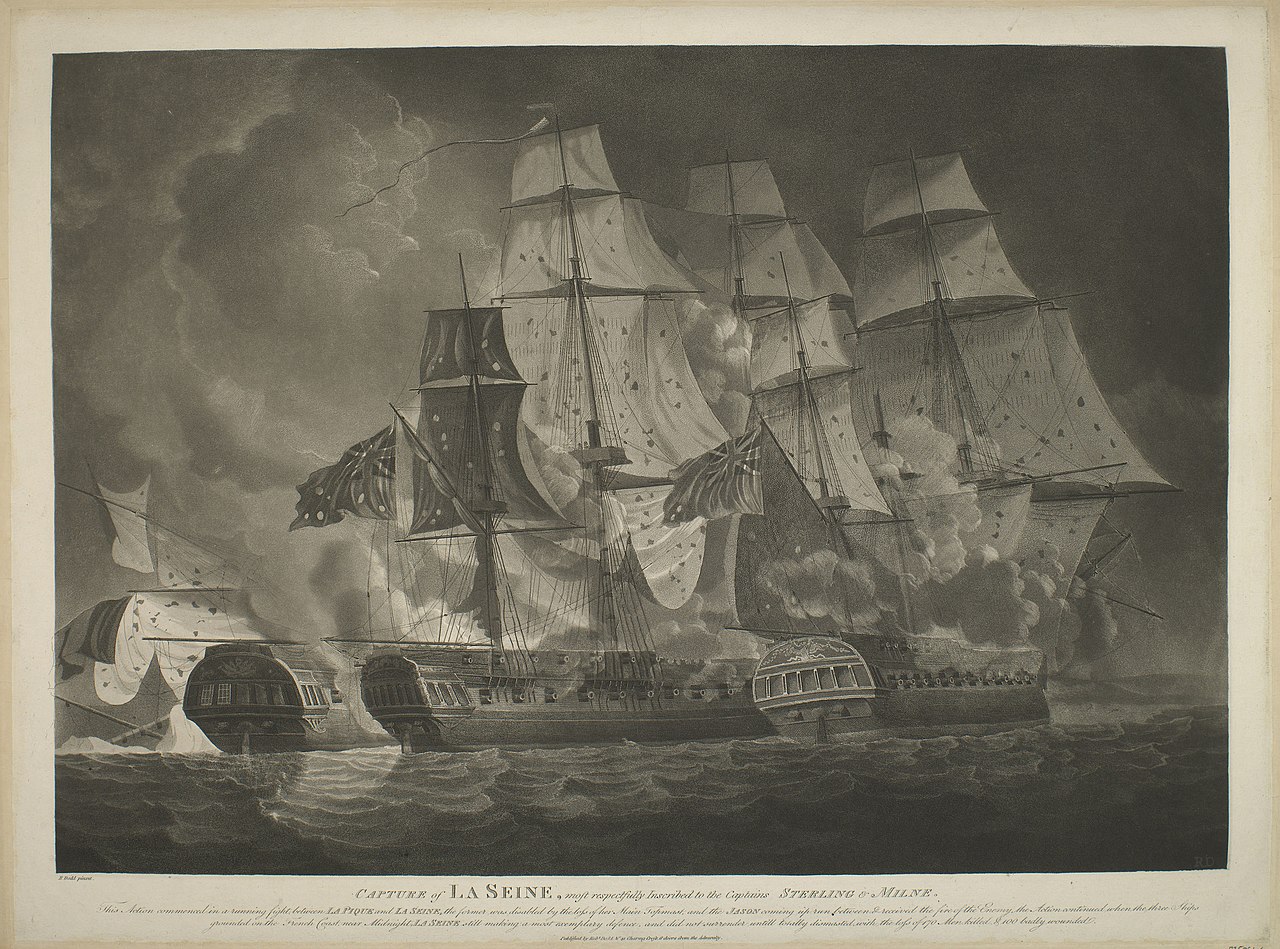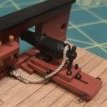-
Posts
2,245 -
Joined
-
Last visited
Reputation Activity
-
 Beef Wellington got a reaction from CiscoH in HMS Jason by Beef Wellington - Caldercraft - 1:64 - Artois-class frigate modified from HMS Diana 1794
Beef Wellington got a reaction from CiscoH in HMS Jason by Beef Wellington - Caldercraft - 1:64 - Artois-class frigate modified from HMS Diana 1794
Thanks for all the 'likes', and Greg, Pat, Mike, Christian, Bob, Tom, Hamilton, Michael, Mobbsie - I really appreciate your thoughts and interest, the good news is that I don't need to decide right now. I got a little over-obsessive on Snake using the kit supplied materials which bogged things down a bit, I'm sure I'd enjoy rigging more with better quality line and be happier with the result. What I'm hoping is that I can leave my options open even after things get closed up when the quarterdeck and f'csle go on (e.g. mast stumps that could easily be replaced with full masts and yards at some point)
BE - your Victory, despite just looking fantastic, presents yet another interesting alternative. I too like that look a lot.
Coamings
Moving on a little, have started on the coamings and gratings. I had ordered some of Chuck's gratings some time ago and these were relatively painless to make up. The coaming dimensions were taken from AOTS with a few small adjustments to ensure the edge of the coaming met the wider binding strakes as illustrated. I did go the whole hog and build these as per TFFM which was good practice, if not slow. Not really much else to say.
Where the companionways are, I did do bit more fiddly work to try and simulate the beams and carlings that would be visible. I'm sure there must be a better way, but the approach I took was as follows:
Build up the bottom of the companionway coaming by 1mm to account for the thickness of the deck (as coamings would sit on the beams/carlings, not the deck) 0.5mm sheet was applied to the side faces to simulate the recess on the interior face Boxwood sheets and strips attached to simulate the beams/carlings. This was not hard once the approach had been figured out as this all still needs to slide in through the holes in the deck (which had to be enlarged a bit). I did decide to paint these black, as is shown to good effect on the contemporary Winchelsea model. I was tempted to leave these natural, but as I had made these out of pear, I felt that another wood tone would be distracting. In any event, black appears to have been quite commonly used toward the end of the century to aid safety by making the companionways more visible against the deck. Bit of a Frankenstein's monster from underneath, but to my eye looks convincing enough when in place.
All the coamings and gratings have been made up and just need some finishing. I was pleased that the coamings lined up with the butt pattern of the planks, because as irregular as they looks, they do correspond with the theoretical placement of the beams below.
The third photo shows the difference in appearance with the added depth in the companionway, vs the coaming simply sitting on the deck for comparison. The last photo shows everything in place. One slight fudge I'm making here is to put a grating into the foremost of the two rearmost openings. This should really be a companionway down to the wardroom, but the keel former realistically presents this being represented, and given that this will barely be glimpsed, a grating went on top instead. The kit plans omit this feature entirely.
-
 Beef Wellington got a reaction from chris watton in HMS Jason by Beef Wellington - Caldercraft - 1:64 - Artois-class frigate modified from HMS Diana 1794
Beef Wellington got a reaction from chris watton in HMS Jason by Beef Wellington - Caldercraft - 1:64 - Artois-class frigate modified from HMS Diana 1794
Interim update:
Anchor chain is on finally, been putting this off but really had to get it done so I could permanently 'right-side' the model...its amazing how many configurations there are on models and there really doesn't seem to be a standard way.
Next up, as a break from the repetitious chore of the gun carriages, was to finish the pumps. I'd been overthinking how to cover the curved surface of the pump covers. In the end, 1x2mm strip was used, with one side angled - wasn't as bad as I thought. Once attached, the thickness was sanded down to try to get a more scale look. Winch bearingsfor the pumps were shaped from strip and painted 'dark iron'. Brown paint was used to simulate the leather washer for the cistern plugs. These will be a little obscured eventually, but I think these details will be visible.
Once the pumps were completed, the next logical step is to figure out how to support these at the main hatch. The kits indicates using wooden strip for this, but contemporary models show an iron bracket and this is what I' like to try to replicate as it seems more appropriate. The main part of the bracket was made using an RB models stanchion, bent to shape and with the hole enlarged with a 0.8mm drill bit to accept the winches that will eventually be installed. The height of these needs to be the same as the winch bearings so that the winch will be parallel to the deck, and they need to be parallel to the deck and over the coamings so the main hatch is not obscured - so this essentially determines the lateral placement of the pumps. I will add an additional bracket which would have been necessary for strength, and you can see a trial made up from some scrap PE to illustrate which I think will do the trick.
I found thinking this through all rather intriguing as there seem to be some obvious problems. For anyone coming from the lower deck, the ladder feads directly over the main hatch grating, and the winch brackets definitely seem to get in the way a bit here here, in addition to having to navigating the pump winches. I can't figure out for the life of me why the ladders don't lead up forward rather than aft as this would seem to be much more practical, but this orientation is clearly shown on the original plans, AOTS Diana, as well as contemporary models...if anyone knows why, please say so!
Now that the positioning of the pump winches is known, the placement of the pillars for the main topsail sheet and main jeer bitts can be determined...which will probably be the next diversion.
-
 Beef Wellington got a reaction from BenD in HMS Jason by Beef Wellington - Caldercraft - 1:64 - Artois-class frigate modified from HMS Diana 1794
Beef Wellington got a reaction from BenD in HMS Jason by Beef Wellington - Caldercraft - 1:64 - Artois-class frigate modified from HMS Diana 1794
Interim update:
Anchor chain is on finally, been putting this off but really had to get it done so I could permanently 'right-side' the model...its amazing how many configurations there are on models and there really doesn't seem to be a standard way.
Next up, as a break from the repetitious chore of the gun carriages, was to finish the pumps. I'd been overthinking how to cover the curved surface of the pump covers. In the end, 1x2mm strip was used, with one side angled - wasn't as bad as I thought. Once attached, the thickness was sanded down to try to get a more scale look. Winch bearingsfor the pumps were shaped from strip and painted 'dark iron'. Brown paint was used to simulate the leather washer for the cistern plugs. These will be a little obscured eventually, but I think these details will be visible.
Once the pumps were completed, the next logical step is to figure out how to support these at the main hatch. The kits indicates using wooden strip for this, but contemporary models show an iron bracket and this is what I' like to try to replicate as it seems more appropriate. The main part of the bracket was made using an RB models stanchion, bent to shape and with the hole enlarged with a 0.8mm drill bit to accept the winches that will eventually be installed. The height of these needs to be the same as the winch bearings so that the winch will be parallel to the deck, and they need to be parallel to the deck and over the coamings so the main hatch is not obscured - so this essentially determines the lateral placement of the pumps. I will add an additional bracket which would have been necessary for strength, and you can see a trial made up from some scrap PE to illustrate which I think will do the trick.
I found thinking this through all rather intriguing as there seem to be some obvious problems. For anyone coming from the lower deck, the ladder feads directly over the main hatch grating, and the winch brackets definitely seem to get in the way a bit here here, in addition to having to navigating the pump winches. I can't figure out for the life of me why the ladders don't lead up forward rather than aft as this would seem to be much more practical, but this orientation is clearly shown on the original plans, AOTS Diana, as well as contemporary models...if anyone knows why, please say so!
Now that the positioning of the pump winches is known, the placement of the pillars for the main topsail sheet and main jeer bitts can be determined...which will probably be the next diversion.
-
 Beef Wellington got a reaction from Landlubber Mike in HMS Jason by Beef Wellington - Caldercraft - 1:64 - Artois-class frigate modified from HMS Diana 1794
Beef Wellington got a reaction from Landlubber Mike in HMS Jason by Beef Wellington - Caldercraft - 1:64 - Artois-class frigate modified from HMS Diana 1794
Interim update:
Anchor chain is on finally, been putting this off but really had to get it done so I could permanently 'right-side' the model...its amazing how many configurations there are on models and there really doesn't seem to be a standard way.
Next up, as a break from the repetitious chore of the gun carriages, was to finish the pumps. I'd been overthinking how to cover the curved surface of the pump covers. In the end, 1x2mm strip was used, with one side angled - wasn't as bad as I thought. Once attached, the thickness was sanded down to try to get a more scale look. Winch bearingsfor the pumps were shaped from strip and painted 'dark iron'. Brown paint was used to simulate the leather washer for the cistern plugs. These will be a little obscured eventually, but I think these details will be visible.
Once the pumps were completed, the next logical step is to figure out how to support these at the main hatch. The kits indicates using wooden strip for this, but contemporary models show an iron bracket and this is what I' like to try to replicate as it seems more appropriate. The main part of the bracket was made using an RB models stanchion, bent to shape and with the hole enlarged with a 0.8mm drill bit to accept the winches that will eventually be installed. The height of these needs to be the same as the winch bearings so that the winch will be parallel to the deck, and they need to be parallel to the deck and over the coamings so the main hatch is not obscured - so this essentially determines the lateral placement of the pumps. I will add an additional bracket which would have been necessary for strength, and you can see a trial made up from some scrap PE to illustrate which I think will do the trick.
I found thinking this through all rather intriguing as there seem to be some obvious problems. For anyone coming from the lower deck, the ladder feads directly over the main hatch grating, and the winch brackets definitely seem to get in the way a bit here here, in addition to having to navigating the pump winches. I can't figure out for the life of me why the ladders don't lead up forward rather than aft as this would seem to be much more practical, but this orientation is clearly shown on the original plans, AOTS Diana, as well as contemporary models...if anyone knows why, please say so!
Now that the positioning of the pump winches is known, the placement of the pillars for the main topsail sheet and main jeer bitts can be determined...which will probably be the next diversion.
-
 Beef Wellington got a reaction from Sargon in HMS Jason by Beef Wellington - Caldercraft - 1:64 - Artois-class frigate modified from HMS Diana 1794
Beef Wellington got a reaction from Sargon in HMS Jason by Beef Wellington - Caldercraft - 1:64 - Artois-class frigate modified from HMS Diana 1794
Interim update:
Anchor chain is on finally, been putting this off but really had to get it done so I could permanently 'right-side' the model...its amazing how many configurations there are on models and there really doesn't seem to be a standard way.
Next up, as a break from the repetitious chore of the gun carriages, was to finish the pumps. I'd been overthinking how to cover the curved surface of the pump covers. In the end, 1x2mm strip was used, with one side angled - wasn't as bad as I thought. Once attached, the thickness was sanded down to try to get a more scale look. Winch bearingsfor the pumps were shaped from strip and painted 'dark iron'. Brown paint was used to simulate the leather washer for the cistern plugs. These will be a little obscured eventually, but I think these details will be visible.
Once the pumps were completed, the next logical step is to figure out how to support these at the main hatch. The kits indicates using wooden strip for this, but contemporary models show an iron bracket and this is what I' like to try to replicate as it seems more appropriate. The main part of the bracket was made using an RB models stanchion, bent to shape and with the hole enlarged with a 0.8mm drill bit to accept the winches that will eventually be installed. The height of these needs to be the same as the winch bearings so that the winch will be parallel to the deck, and they need to be parallel to the deck and over the coamings so the main hatch is not obscured - so this essentially determines the lateral placement of the pumps. I will add an additional bracket which would have been necessary for strength, and you can see a trial made up from some scrap PE to illustrate which I think will do the trick.
I found thinking this through all rather intriguing as there seem to be some obvious problems. For anyone coming from the lower deck, the ladder feads directly over the main hatch grating, and the winch brackets definitely seem to get in the way a bit here here, in addition to having to navigating the pump winches. I can't figure out for the life of me why the ladders don't lead up forward rather than aft as this would seem to be much more practical, but this orientation is clearly shown on the original plans, AOTS Diana, as well as contemporary models...if anyone knows why, please say so!
Now that the positioning of the pump winches is known, the placement of the pillars for the main topsail sheet and main jeer bitts can be determined...which will probably be the next diversion.
-
 Beef Wellington got a reaction from Landlubber Mike in HMS Jason by Beef Wellington - Caldercraft - 1:64 - Artois-class frigate modified from HMS Diana 1794
Beef Wellington got a reaction from Landlubber Mike in HMS Jason by Beef Wellington - Caldercraft - 1:64 - Artois-class frigate modified from HMS Diana 1794
Gun Carriages:
Nothing revolutionary, prototype gun carriage has been completed after putting on some more coats of paint to the carriages. Learning experience here is to use as little paint on metal items as possible, all ring bolts and ring bolts have been chemically blackened. Cannon barrels and ring bolts have been finished with Testors clear matt lacquer to eliminate the shine still inherent to the blackened surface. The carriage bolts are model railway/railroad track pins which have a shallow domed head, these come painted black, so the head was painted with 'dark iron' before attaching. I had experimented with countersinking these on a spare, but this seemed a little over fussy, and also just using wire cut off wire but felt these looked too dainty.
Event though many of these will be obscured by the deck, I will probably build all of these as per the prototype in case glimpses can be seen through various openings. The guns that are highly visible will likely get a little more detailing but I'll decide to what extent when all of these are done.
Its a little disconcerting when I sat back a figured out what will be needed, and this is just the upper deck. Everything is at least now ready for assembly....
ringbolts - 336 blackened (7 per carriage, 4 per bulwark, 1 deck bolt) Domed pins - 168 (6 per carriage) 3mm rings - 112 (2 per carriage for breaching rope, 2 per gunport for breaching rope) 2mm rings - 28 (1 per gunport deckring)
So far 3 carriages have been built up, as the best method for construction becomes clearer, these do seem to be going together more quickly, but still not quickly 🙂
-
 Beef Wellington got a reaction from jwvolz in HMS Jason by Beef Wellington - Caldercraft - 1:64 - Artois-class frigate modified from HMS Diana 1794
Beef Wellington got a reaction from jwvolz in HMS Jason by Beef Wellington - Caldercraft - 1:64 - Artois-class frigate modified from HMS Diana 1794
Interim update:
Anchor chain is on finally, been putting this off but really had to get it done so I could permanently 'right-side' the model...its amazing how many configurations there are on models and there really doesn't seem to be a standard way.
Next up, as a break from the repetitious chore of the gun carriages, was to finish the pumps. I'd been overthinking how to cover the curved surface of the pump covers. In the end, 1x2mm strip was used, with one side angled - wasn't as bad as I thought. Once attached, the thickness was sanded down to try to get a more scale look. Winch bearingsfor the pumps were shaped from strip and painted 'dark iron'. Brown paint was used to simulate the leather washer for the cistern plugs. These will be a little obscured eventually, but I think these details will be visible.
Once the pumps were completed, the next logical step is to figure out how to support these at the main hatch. The kits indicates using wooden strip for this, but contemporary models show an iron bracket and this is what I' like to try to replicate as it seems more appropriate. The main part of the bracket was made using an RB models stanchion, bent to shape and with the hole enlarged with a 0.8mm drill bit to accept the winches that will eventually be installed. The height of these needs to be the same as the winch bearings so that the winch will be parallel to the deck, and they need to be parallel to the deck and over the coamings so the main hatch is not obscured - so this essentially determines the lateral placement of the pumps. I will add an additional bracket which would have been necessary for strength, and you can see a trial made up from some scrap PE to illustrate which I think will do the trick.
I found thinking this through all rather intriguing as there seem to be some obvious problems. For anyone coming from the lower deck, the ladder feads directly over the main hatch grating, and the winch brackets definitely seem to get in the way a bit here here, in addition to having to navigating the pump winches. I can't figure out for the life of me why the ladders don't lead up forward rather than aft as this would seem to be much more practical, but this orientation is clearly shown on the original plans, AOTS Diana, as well as contemporary models...if anyone knows why, please say so!
Now that the positioning of the pump winches is known, the placement of the pillars for the main topsail sheet and main jeer bitts can be determined...which will probably be the next diversion.
-
 Beef Wellington got a reaction from drtrap in HMS Jason by Beef Wellington - Caldercraft - 1:64 - Artois-class frigate modified from HMS Diana 1794
Beef Wellington got a reaction from drtrap in HMS Jason by Beef Wellington - Caldercraft - 1:64 - Artois-class frigate modified from HMS Diana 1794
Interim update:
Anchor chain is on finally, been putting this off but really had to get it done so I could permanently 'right-side' the model...its amazing how many configurations there are on models and there really doesn't seem to be a standard way.
Next up, as a break from the repetitious chore of the gun carriages, was to finish the pumps. I'd been overthinking how to cover the curved surface of the pump covers. In the end, 1x2mm strip was used, with one side angled - wasn't as bad as I thought. Once attached, the thickness was sanded down to try to get a more scale look. Winch bearingsfor the pumps were shaped from strip and painted 'dark iron'. Brown paint was used to simulate the leather washer for the cistern plugs. These will be a little obscured eventually, but I think these details will be visible.
Once the pumps were completed, the next logical step is to figure out how to support these at the main hatch. The kits indicates using wooden strip for this, but contemporary models show an iron bracket and this is what I' like to try to replicate as it seems more appropriate. The main part of the bracket was made using an RB models stanchion, bent to shape and with the hole enlarged with a 0.8mm drill bit to accept the winches that will eventually be installed. The height of these needs to be the same as the winch bearings so that the winch will be parallel to the deck, and they need to be parallel to the deck and over the coamings so the main hatch is not obscured - so this essentially determines the lateral placement of the pumps. I will add an additional bracket which would have been necessary for strength, and you can see a trial made up from some scrap PE to illustrate which I think will do the trick.
I found thinking this through all rather intriguing as there seem to be some obvious problems. For anyone coming from the lower deck, the ladder feads directly over the main hatch grating, and the winch brackets definitely seem to get in the way a bit here here, in addition to having to navigating the pump winches. I can't figure out for the life of me why the ladders don't lead up forward rather than aft as this would seem to be much more practical, but this orientation is clearly shown on the original plans, AOTS Diana, as well as contemporary models...if anyone knows why, please say so!
Now that the positioning of the pump winches is known, the placement of the pillars for the main topsail sheet and main jeer bitts can be determined...which will probably be the next diversion.
-
 Beef Wellington got a reaction from paulsutcliffe in HMS Jason by Beef Wellington - Caldercraft - 1:64 - Artois-class frigate modified from HMS Diana 1794
Beef Wellington got a reaction from paulsutcliffe in HMS Jason by Beef Wellington - Caldercraft - 1:64 - Artois-class frigate modified from HMS Diana 1794
Interim update:
Anchor chain is on finally, been putting this off but really had to get it done so I could permanently 'right-side' the model...its amazing how many configurations there are on models and there really doesn't seem to be a standard way.
Next up, as a break from the repetitious chore of the gun carriages, was to finish the pumps. I'd been overthinking how to cover the curved surface of the pump covers. In the end, 1x2mm strip was used, with one side angled - wasn't as bad as I thought. Once attached, the thickness was sanded down to try to get a more scale look. Winch bearingsfor the pumps were shaped from strip and painted 'dark iron'. Brown paint was used to simulate the leather washer for the cistern plugs. These will be a little obscured eventually, but I think these details will be visible.
Once the pumps were completed, the next logical step is to figure out how to support these at the main hatch. The kits indicates using wooden strip for this, but contemporary models show an iron bracket and this is what I' like to try to replicate as it seems more appropriate. The main part of the bracket was made using an RB models stanchion, bent to shape and with the hole enlarged with a 0.8mm drill bit to accept the winches that will eventually be installed. The height of these needs to be the same as the winch bearings so that the winch will be parallel to the deck, and they need to be parallel to the deck and over the coamings so the main hatch is not obscured - so this essentially determines the lateral placement of the pumps. I will add an additional bracket which would have been necessary for strength, and you can see a trial made up from some scrap PE to illustrate which I think will do the trick.
I found thinking this through all rather intriguing as there seem to be some obvious problems. For anyone coming from the lower deck, the ladder feads directly over the main hatch grating, and the winch brackets definitely seem to get in the way a bit here here, in addition to having to navigating the pump winches. I can't figure out for the life of me why the ladders don't lead up forward rather than aft as this would seem to be much more practical, but this orientation is clearly shown on the original plans, AOTS Diana, as well as contemporary models...if anyone knows why, please say so!
Now that the positioning of the pump winches is known, the placement of the pillars for the main topsail sheet and main jeer bitts can be determined...which will probably be the next diversion.
-
 Beef Wellington got a reaction from JpR62 in HMS Jason by Beef Wellington - Caldercraft - 1:64 - Artois-class frigate modified from HMS Diana 1794
Beef Wellington got a reaction from JpR62 in HMS Jason by Beef Wellington - Caldercraft - 1:64 - Artois-class frigate modified from HMS Diana 1794
Interim update:
Anchor chain is on finally, been putting this off but really had to get it done so I could permanently 'right-side' the model...its amazing how many configurations there are on models and there really doesn't seem to be a standard way.
Next up, as a break from the repetitious chore of the gun carriages, was to finish the pumps. I'd been overthinking how to cover the curved surface of the pump covers. In the end, 1x2mm strip was used, with one side angled - wasn't as bad as I thought. Once attached, the thickness was sanded down to try to get a more scale look. Winch bearingsfor the pumps were shaped from strip and painted 'dark iron'. Brown paint was used to simulate the leather washer for the cistern plugs. These will be a little obscured eventually, but I think these details will be visible.
Once the pumps were completed, the next logical step is to figure out how to support these at the main hatch. The kits indicates using wooden strip for this, but contemporary models show an iron bracket and this is what I' like to try to replicate as it seems more appropriate. The main part of the bracket was made using an RB models stanchion, bent to shape and with the hole enlarged with a 0.8mm drill bit to accept the winches that will eventually be installed. The height of these needs to be the same as the winch bearings so that the winch will be parallel to the deck, and they need to be parallel to the deck and over the coamings so the main hatch is not obscured - so this essentially determines the lateral placement of the pumps. I will add an additional bracket which would have been necessary for strength, and you can see a trial made up from some scrap PE to illustrate which I think will do the trick.
I found thinking this through all rather intriguing as there seem to be some obvious problems. For anyone coming from the lower deck, the ladder feads directly over the main hatch grating, and the winch brackets definitely seem to get in the way a bit here here, in addition to having to navigating the pump winches. I can't figure out for the life of me why the ladders don't lead up forward rather than aft as this would seem to be much more practical, but this orientation is clearly shown on the original plans, AOTS Diana, as well as contemporary models...if anyone knows why, please say so!
Now that the positioning of the pump winches is known, the placement of the pillars for the main topsail sheet and main jeer bitts can be determined...which will probably be the next diversion.
-
 Beef Wellington got a reaction from egkb in HMS Jason by Beef Wellington - Caldercraft - 1:64 - Artois-class frigate modified from HMS Diana 1794
Beef Wellington got a reaction from egkb in HMS Jason by Beef Wellington - Caldercraft - 1:64 - Artois-class frigate modified from HMS Diana 1794
Interim update:
Anchor chain is on finally, been putting this off but really had to get it done so I could permanently 'right-side' the model...its amazing how many configurations there are on models and there really doesn't seem to be a standard way.
Next up, as a break from the repetitious chore of the gun carriages, was to finish the pumps. I'd been overthinking how to cover the curved surface of the pump covers. In the end, 1x2mm strip was used, with one side angled - wasn't as bad as I thought. Once attached, the thickness was sanded down to try to get a more scale look. Winch bearingsfor the pumps were shaped from strip and painted 'dark iron'. Brown paint was used to simulate the leather washer for the cistern plugs. These will be a little obscured eventually, but I think these details will be visible.
Once the pumps were completed, the next logical step is to figure out how to support these at the main hatch. The kits indicates using wooden strip for this, but contemporary models show an iron bracket and this is what I' like to try to replicate as it seems more appropriate. The main part of the bracket was made using an RB models stanchion, bent to shape and with the hole enlarged with a 0.8mm drill bit to accept the winches that will eventually be installed. The height of these needs to be the same as the winch bearings so that the winch will be parallel to the deck, and they need to be parallel to the deck and over the coamings so the main hatch is not obscured - so this essentially determines the lateral placement of the pumps. I will add an additional bracket which would have been necessary for strength, and you can see a trial made up from some scrap PE to illustrate which I think will do the trick.
I found thinking this through all rather intriguing as there seem to be some obvious problems. For anyone coming from the lower deck, the ladder feads directly over the main hatch grating, and the winch brackets definitely seem to get in the way a bit here here, in addition to having to navigating the pump winches. I can't figure out for the life of me why the ladders don't lead up forward rather than aft as this would seem to be much more practical, but this orientation is clearly shown on the original plans, AOTS Diana, as well as contemporary models...if anyone knows why, please say so!
Now that the positioning of the pump winches is known, the placement of the pillars for the main topsail sheet and main jeer bitts can be determined...which will probably be the next diversion.
-
 Beef Wellington got a reaction from JesseLee in HMS Jason by Beef Wellington - Caldercraft - 1:64 - Artois-class frigate modified from HMS Diana 1794
Beef Wellington got a reaction from JesseLee in HMS Jason by Beef Wellington - Caldercraft - 1:64 - Artois-class frigate modified from HMS Diana 1794
Interim update:
Anchor chain is on finally, been putting this off but really had to get it done so I could permanently 'right-side' the model...its amazing how many configurations there are on models and there really doesn't seem to be a standard way.
Next up, as a break from the repetitious chore of the gun carriages, was to finish the pumps. I'd been overthinking how to cover the curved surface of the pump covers. In the end, 1x2mm strip was used, with one side angled - wasn't as bad as I thought. Once attached, the thickness was sanded down to try to get a more scale look. Winch bearingsfor the pumps were shaped from strip and painted 'dark iron'. Brown paint was used to simulate the leather washer for the cistern plugs. These will be a little obscured eventually, but I think these details will be visible.
Once the pumps were completed, the next logical step is to figure out how to support these at the main hatch. The kits indicates using wooden strip for this, but contemporary models show an iron bracket and this is what I' like to try to replicate as it seems more appropriate. The main part of the bracket was made using an RB models stanchion, bent to shape and with the hole enlarged with a 0.8mm drill bit to accept the winches that will eventually be installed. The height of these needs to be the same as the winch bearings so that the winch will be parallel to the deck, and they need to be parallel to the deck and over the coamings so the main hatch is not obscured - so this essentially determines the lateral placement of the pumps. I will add an additional bracket which would have been necessary for strength, and you can see a trial made up from some scrap PE to illustrate which I think will do the trick.
I found thinking this through all rather intriguing as there seem to be some obvious problems. For anyone coming from the lower deck, the ladder feads directly over the main hatch grating, and the winch brackets definitely seem to get in the way a bit here here, in addition to having to navigating the pump winches. I can't figure out for the life of me why the ladders don't lead up forward rather than aft as this would seem to be much more practical, but this orientation is clearly shown on the original plans, AOTS Diana, as well as contemporary models...if anyone knows why, please say so!
Now that the positioning of the pump winches is known, the placement of the pillars for the main topsail sheet and main jeer bitts can be determined...which will probably be the next diversion.
-
 Beef Wellington got a reaction from Dfell in HMS Jason by Beef Wellington - Caldercraft - 1:64 - Artois-class frigate modified from HMS Diana 1794
Beef Wellington got a reaction from Dfell in HMS Jason by Beef Wellington - Caldercraft - 1:64 - Artois-class frigate modified from HMS Diana 1794
Interim update:
Anchor chain is on finally, been putting this off but really had to get it done so I could permanently 'right-side' the model...its amazing how many configurations there are on models and there really doesn't seem to be a standard way.
Next up, as a break from the repetitious chore of the gun carriages, was to finish the pumps. I'd been overthinking how to cover the curved surface of the pump covers. In the end, 1x2mm strip was used, with one side angled - wasn't as bad as I thought. Once attached, the thickness was sanded down to try to get a more scale look. Winch bearingsfor the pumps were shaped from strip and painted 'dark iron'. Brown paint was used to simulate the leather washer for the cistern plugs. These will be a little obscured eventually, but I think these details will be visible.
Once the pumps were completed, the next logical step is to figure out how to support these at the main hatch. The kits indicates using wooden strip for this, but contemporary models show an iron bracket and this is what I' like to try to replicate as it seems more appropriate. The main part of the bracket was made using an RB models stanchion, bent to shape and with the hole enlarged with a 0.8mm drill bit to accept the winches that will eventually be installed. The height of these needs to be the same as the winch bearings so that the winch will be parallel to the deck, and they need to be parallel to the deck and over the coamings so the main hatch is not obscured - so this essentially determines the lateral placement of the pumps. I will add an additional bracket which would have been necessary for strength, and you can see a trial made up from some scrap PE to illustrate which I think will do the trick.
I found thinking this through all rather intriguing as there seem to be some obvious problems. For anyone coming from the lower deck, the ladder feads directly over the main hatch grating, and the winch brackets definitely seem to get in the way a bit here here, in addition to having to navigating the pump winches. I can't figure out for the life of me why the ladders don't lead up forward rather than aft as this would seem to be much more practical, but this orientation is clearly shown on the original plans, AOTS Diana, as well as contemporary models...if anyone knows why, please say so!
Now that the positioning of the pump winches is known, the placement of the pillars for the main topsail sheet and main jeer bitts can be determined...which will probably be the next diversion.
-
 Beef Wellington got a reaction from rafine in HMS Jason by Beef Wellington - Caldercraft - 1:64 - Artois-class frigate modified from HMS Diana 1794
Beef Wellington got a reaction from rafine in HMS Jason by Beef Wellington - Caldercraft - 1:64 - Artois-class frigate modified from HMS Diana 1794
Interim update:
Anchor chain is on finally, been putting this off but really had to get it done so I could permanently 'right-side' the model...its amazing how many configurations there are on models and there really doesn't seem to be a standard way.
Next up, as a break from the repetitious chore of the gun carriages, was to finish the pumps. I'd been overthinking how to cover the curved surface of the pump covers. In the end, 1x2mm strip was used, with one side angled - wasn't as bad as I thought. Once attached, the thickness was sanded down to try to get a more scale look. Winch bearingsfor the pumps were shaped from strip and painted 'dark iron'. Brown paint was used to simulate the leather washer for the cistern plugs. These will be a little obscured eventually, but I think these details will be visible.
Once the pumps were completed, the next logical step is to figure out how to support these at the main hatch. The kits indicates using wooden strip for this, but contemporary models show an iron bracket and this is what I' like to try to replicate as it seems more appropriate. The main part of the bracket was made using an RB models stanchion, bent to shape and with the hole enlarged with a 0.8mm drill bit to accept the winches that will eventually be installed. The height of these needs to be the same as the winch bearings so that the winch will be parallel to the deck, and they need to be parallel to the deck and over the coamings so the main hatch is not obscured - so this essentially determines the lateral placement of the pumps. I will add an additional bracket which would have been necessary for strength, and you can see a trial made up from some scrap PE to illustrate which I think will do the trick.
I found thinking this through all rather intriguing as there seem to be some obvious problems. For anyone coming from the lower deck, the ladder feads directly over the main hatch grating, and the winch brackets definitely seem to get in the way a bit here here, in addition to having to navigating the pump winches. I can't figure out for the life of me why the ladders don't lead up forward rather than aft as this would seem to be much more practical, but this orientation is clearly shown on the original plans, AOTS Diana, as well as contemporary models...if anyone knows why, please say so!
Now that the positioning of the pump winches is known, the placement of the pillars for the main topsail sheet and main jeer bitts can be determined...which will probably be the next diversion.
-
 Beef Wellington got a reaction from DaveBaxt in HMS Jason by Beef Wellington - Caldercraft - 1:64 - Artois-class frigate modified from HMS Diana 1794
Beef Wellington got a reaction from DaveBaxt in HMS Jason by Beef Wellington - Caldercraft - 1:64 - Artois-class frigate modified from HMS Diana 1794
Nice hear from you John
Mobbsie - cheers mate, though I think you're being a bit generous with the praise
Well, bit of a milestone, the upper deck is finally completed and glued into position. Next step will be the interior bulwarks, will require some tweaking as a few test planks indicate that the bulwarks (even after shaping) still will be a bit wavy, I'll probably just add some thin scrap strips to the these to build them up, but more on that when its done.
The instructions make no mention of some deck former beams that need to go on before the upper deck, the only reference is on the side plan - I nearly missed them. When in position there is clearly a problem because the beams will interfere with the open companions, once again the plans clearly show this issue. Simple to cut out the center section without any real structural implications, the ones remaining will be hidden by gratings. You can also see in the picture that I glued some thin beech off cuts where the two halves will join to provide some surface to mate the deck surfaces smoothly. Deck was glued in multiple stages, first half deck glued to center line, section half deck glued to center and mated, and then glued down to the bulkheads to give correct camber.
Final result....completing the decking off the ship seems to have worked out just fine.
Size comparison to Snake which is still laid up....Jason will be a big boy!
-
 Beef Wellington got a reaction from DaveBaxt in HMS Jason by Beef Wellington - Caldercraft - 1:64 - Artois-class frigate modified from HMS Diana 1794
Beef Wellington got a reaction from DaveBaxt in HMS Jason by Beef Wellington - Caldercraft - 1:64 - Artois-class frigate modified from HMS Diana 1794
Decided I really needed to post few pics to show I'm still here. With the weather turning, and the end of the soccer/football season approaching (I coach my son and daughters teams) I can finally foresee more time in the shipyard in the evenings. I had spent a lot of time trying to figure out the deck arrangement, picture are pretty self explanatory and work obviously still in progress. Margin planks are not glued yet, but I did cut my first scarf joint. As mentioned previously, estimating the line of the margin plank required the future shape of the interior bulwark once planked to be estimated - I won't know that I've been successful until its too late.
Unfortunately, at lot of this will not be seen once the quarter deck and forecastle are in place, but its good practice and building my confidence to tackle the more visible top decks.
-
 Beef Wellington got a reaction from ccoyle in HMS Jason by Beef Wellington - Caldercraft - 1:64 - Artois-class frigate modified from HMS Diana 1794
Beef Wellington got a reaction from ccoyle in HMS Jason by Beef Wellington - Caldercraft - 1:64 - Artois-class frigate modified from HMS Diana 1794
Interim update:
Anchor chain is on finally, been putting this off but really had to get it done so I could permanently 'right-side' the model...its amazing how many configurations there are on models and there really doesn't seem to be a standard way.
Next up, as a break from the repetitious chore of the gun carriages, was to finish the pumps. I'd been overthinking how to cover the curved surface of the pump covers. In the end, 1x2mm strip was used, with one side angled - wasn't as bad as I thought. Once attached, the thickness was sanded down to try to get a more scale look. Winch bearingsfor the pumps were shaped from strip and painted 'dark iron'. Brown paint was used to simulate the leather washer for the cistern plugs. These will be a little obscured eventually, but I think these details will be visible.
Once the pumps were completed, the next logical step is to figure out how to support these at the main hatch. The kits indicates using wooden strip for this, but contemporary models show an iron bracket and this is what I' like to try to replicate as it seems more appropriate. The main part of the bracket was made using an RB models stanchion, bent to shape and with the hole enlarged with a 0.8mm drill bit to accept the winches that will eventually be installed. The height of these needs to be the same as the winch bearings so that the winch will be parallel to the deck, and they need to be parallel to the deck and over the coamings so the main hatch is not obscured - so this essentially determines the lateral placement of the pumps. I will add an additional bracket which would have been necessary for strength, and you can see a trial made up from some scrap PE to illustrate which I think will do the trick.
I found thinking this through all rather intriguing as there seem to be some obvious problems. For anyone coming from the lower deck, the ladder feads directly over the main hatch grating, and the winch brackets definitely seem to get in the way a bit here here, in addition to having to navigating the pump winches. I can't figure out for the life of me why the ladders don't lead up forward rather than aft as this would seem to be much more practical, but this orientation is clearly shown on the original plans, AOTS Diana, as well as contemporary models...if anyone knows why, please say so!
Now that the positioning of the pump winches is known, the placement of the pillars for the main topsail sheet and main jeer bitts can be determined...which will probably be the next diversion.
-
 Beef Wellington reacted to Tim Curtis in HMS Jason by Beef Wellington - Caldercraft - 1:64 - Artois-class frigate modified from HMS Diana 1794
Beef Wellington reacted to Tim Curtis in HMS Jason by Beef Wellington - Caldercraft - 1:64 - Artois-class frigate modified from HMS Diana 1794
Great work.
Well done in being patient. They look superb.
And remember you only have 150 or so tiny blocks to strop and seize for the breaching ropes etc.
#gottalovetheguns
Tim
-
 Beef Wellington reacted to Gahm in HMS Jason by Beef Wellington - Caldercraft - 1:64 - Artois-class frigate modified from HMS Diana 1794
Beef Wellington reacted to Gahm in HMS Jason by Beef Wellington - Caldercraft - 1:64 - Artois-class frigate modified from HMS Diana 1794
These are great looking guns! It took me forever to do the 18 guns on my Syren . . . I am in awe of the work load you are facing 😉
Thomas
-
 Beef Wellington reacted to BANYAN in HMS Jason by Beef Wellington - Caldercraft - 1:64 - Artois-class frigate modified from HMS Diana 1794
Beef Wellington reacted to BANYAN in HMS Jason by Beef Wellington - Caldercraft - 1:64 - Artois-class frigate modified from HMS Diana 1794
Nice work Jason; a real production line you have going there. Those canon ook great!
cheers
Pat
-
 Beef Wellington reacted to RGL in HMS King George V by RGL - FINISHED - Tamiya - 1/350 - PLASTIC
Beef Wellington reacted to RGL in HMS King George V by RGL - FINISHED - Tamiya - 1/350 - PLASTIC
Well that’s the worst part of the build done. The stanchions are white as I gave them a base primer coat from the Tamiya rattle can before putting them on, as another coat would plug up the holes. When I do the touch up phase I will make sure they are all strait and paint them.
The Anchors are resin ones from North Star Models as the kit ones are utter rubbish. There are only two as no reference I can see has her with three after 1940.
-
 Beef Wellington reacted to RGL in HMS King George V by RGL - FINISHED - Tamiya - 1/350 - PLASTIC
Beef Wellington reacted to RGL in HMS King George V by RGL - FINISHED - Tamiya - 1/350 - PLASTIC
So I tried a new technique today. First, get a mouthful of black coffee. Second sneeze. Third, direct sneeze over the ship. Drench it in coffee.
FFS! 20 minutes with a paintbrush and water to clean it up. The deck does not like it but I think I’m on to something here when it comes to dulling down the wooden decks! Who knew!
Anyways, the back end of the ship’s railing is now done. I added a little bit of unpainted PE for comparison and I like it better the way I’m doing it. I just don’t think I can go back to PE railing again for this type of ship’s rails.
-
 Beef Wellington reacted to RGL in HMS King George V by RGL - FINISHED - Tamiya - 1/350 - PLASTIC
Beef Wellington reacted to RGL in HMS King George V by RGL - FINISHED - Tamiya - 1/350 - PLASTIC
The 2 ships cranes, horrible instructions and I needed to add on a few extras so the rigging is correct but now they’re attached I’m fairly happy. I just have to hang a plane off one.
-
 Beef Wellington reacted to RGL in HMS King George V by RGL - FINISHED - Tamiya - 1/350 - PLASTIC
Beef Wellington reacted to RGL in HMS King George V by RGL - FINISHED - Tamiya - 1/350 - PLASTIC
Nearly there! Ammo boxes, deck equipment, new chains to keep @Dubz happy! 34 individual 20mm guns. Plus a ship’s bell.
The ships plane, railings (not looking forward to a week of rigging stanchions, davits; light weathering.
Oh, and the screws. Starting to look like a warship.
-
 Beef Wellington reacted to RMC in Granado by RMC - FINISHED - Caldercraft - 1:64
Beef Wellington reacted to RMC in Granado by RMC - FINISHED - Caldercraft - 1:64
Thanks for your good wishes Rob.
I couldn't resist. I have had a very close look at the Anatomy of a Ship. The lids are NOT quite flush with the counter. So here is my solution and the process of taking off a layer of planking was rather fraught. At the moment the lid is dry-fitted and the photos exaggerate the faults. Obviously it needs to be touched up, but once painted, should look quite acceptable. All I have to do is a similar job on the other side - but that really will have to wait.













